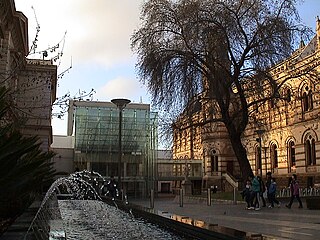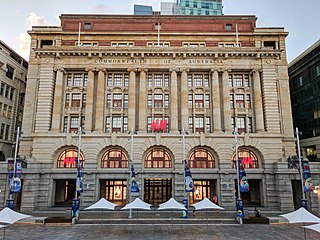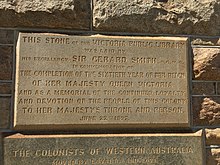
The National Library of Australia (NLA), formerly the Commonwealth National Library and Commonwealth Parliament Library, is the largest reference library in Australia, responsible under the terms of the National Library Act 1960 for "maintaining and developing a national collection of library material, including a comprehensive collection of library material relating to Australia and the Australian people", thus functioning as a national library. It is located in Parkes, Canberra, ACT.

The State Library of Queensland is the main reference and research library provided to the people of the State of Queensland, Australia, by the state government. The Library is governed by the Library Board of Queensland, which draws its powers from the Libraries Act 1988. It contains a significant portion of Queensland's documentary heritage, major reference and research collections, and is an advocate of and partner with public libraries across Queensland. The Library is at Kurilpa Point, within the Queensland Cultural Centre on the Brisbane River at South Bank.

The State Library of South Australia, or SLSA, formerly known as the Public Library of South Australia, located on North Terrace, Adelaide, is the official library of the Australian state of South Australia. It is the largest public research library in the state, with a collection focus on South Australian information, being the repository of all printed and audiovisual material published in the state, as required by legal deposit legislation. It holds the "South Australiana" collection, which documents South Australia from pre-European settlement to the present day, as well as general reference material in a wide range of formats, including digital, film, sound and video recordings, photographs, and microfiche. Home access to many journals, newspapers and other resources online is available.
The Western Australian Museum is a statutory authority within the Culture and the Arts Portfolio, established under the Museum Act 1969.

Blackboy Hill was named after the Australian native "black boy" plants, Xanthorrhoea preissii, which dominated the site which is now absorbed into Greenmount, Western Australia.

WAY 79, also referred to as WAY '79 and WAY 1979, was the official 1979 sesquicentennial celebration of the European colonisation of Western Australia.
The J S Battye Library is an arm of the State Library of Western Australia. It stores much of the state's historical records and original publications including books, newspapers, periodicals, maps, and ephemera, as well as oral history tapes, photographs and artworks, films and video, and non-government records which are kept in the library's Private Archives collection. The Library provides a range of services, including reference, copying, and genealogical services, as well as consultancy and reader education.

James Sykes Battye (1871–1954) was an Australian librarian who was the first chief librarian of the Victoria Public Library in Perth, Western Australia. He was a leading historian, librarian and public figure in Western Australia and also served as a Chancellor of the University of Western Australia.

The Art Gallery of Western Australia (AGWA) is a public art gallery that is part of the Perth Cultural Centre, in Perth. It is located near the Western Australian Museum and State Library of Western Australia and is supported and managed by the Department of Local Government, Sport and Cultural Industries of the Government of Western Australia. The current gallery main building opened in 1979. It is linked to the old court house – The Centenary Galleries.
The State Records Office of Western Australia (SRO) is the Western Australian government authority with responsibility for identifying, managing, preserving and providing access to the state's archives. The SRO also delivers best-practice records management services to state and local government agencies.

The Alexander Library Building is located in the Cultural Centre of Perth, Western Australia.
The Western Australia Post Office Directory, also known as Wise Directories or Wise Street Directories, was published in Perth in 1893–1949.

The State Library of Tasmania is the reference, special collections, research and public lending library in the Tasmanian capital of Hobart, Australia. It is part of Libraries Tasmania. Libraries Tasmania includes a state-wide network of library services, community learning, adult literacy and the State’s archives and heritage services.
The Northern Suburbs Transit System is the name given to the project initiated and funded by the Government of Western Australia to provide high-speed passenger rail services to the northern corridor of metropolitan Perth, the capital city of Western Australia. The project was commenced by the Dowding Labor government in the late 1980s, and its main feature project was the Joondalup railway line and linked bus services, which have been a core component of the Transperth transport network since the line's opening to passengers on 21 March 1993.

Library & Archives NT comprises the Northern Territory Library and the two Northern Territory Archives Centres in Darwin and Alice Springs. Located in Parliament House in Darwin City, it is the premier public research and archival organisation focused on the history, development and culture of the Northern Territory of Australia. The library holds more than 108,000 books and 30,000 items. The archive holds Northern Territory Government records, which are normally opened 30 years after they were created.

The East Perth Power Station is a disused power station in East Perth, Western Australia. For most of its life it was coal-fired, but ran on oil for six years. The site consists of a complex of industrial buildings occupying more than 8.5 hectares, bounded by East Parade, Summers Street, the Swan River and the Graham Farmer Freeway.

In 1929, Western Australia (WA) celebrated the centenary of the founding of Perth and the establishment of the Swan River Colony, the first permanent European settlement in WA. A variety of events were run in Perth, regional areas throughout the state, and even across Australia such as the Western Australian Centenary Air Race.

The General Post Office is a heritage landmark building in Perth, Western Australia. Located on the western side of Forrest Place in the city's central business district, its imposing stone facade is in the Beaux-Arts style. The building was completed in 1923 after almost a decade of construction, which was protracted by World War I and the resulting shortages of construction materials. At the time of its opening, it was the largest building in Perth.

The Pensioner Guards were English military personnel who served on convict transportation ships en route to the Swan River Colony between 1850 and 1868, and were given employment and grants of land on arrival. Their initial employment lasted for six months, or the duration of the voyage, whichever was the longer time. After this they became "pensioners" and had to serve 12 days per year as well as whenever called upon. They paraded annually in Perth at the Pensioner Barracks. Part of their purpose was to fulfil a promise by the British government to send free settlers to the colony to dilute the convicts, and to maintain law and order in the colony.
National edeposit (NED) is a collaboration between Australia's nine national, state and territory libraries which provides for the legal deposit, management, storage and preservation of, and access to, published electronic material across Australia. It is a website, a system and a service, the result of a project by National and State Libraries Australia, and is a world-first collaboration. The National Library of Australia (NLA), Libraries ACT, Libraries Tasmania, Northern Territory Library, State Library of New South Wales, State Library of Queensland, State Library of South Australia, State Library Victoria and the State Library of Western Australia are the member organisations, while the system is hosted and managed by the NLA.

























